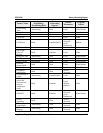
NOTE: Pressing any button (mute, hold, etc.) on the speakerphone while in
full-duplex mode causes the system to perform the “speech training” test
again. For example, if you press MUTE while in full-duplex mode, when
you release the call from mute, the system will perform the entire “speech
training” test.
To maximize the usefulness of your full-duplex speakerphone, take note of these
following observations about full-duplex speakerphone operation.
•
The full duplex operating mode requires a small amount of time to adapt
to changes in echo; therefore, you should avoid making any movements in
the vicinity—about a one-foot radius—of the speakerphone.
•
There are certain echo limits beyond which the speakerphone cannot
effect canceling. These limits are as follows: room echoes beyond 39 mil
-
liseconds (standard configuration) and line echoes beyond 24 millisec
-
onds (standard configuration).
•
The speakerphone may automatically reduce the volume in each direction
when both you and the distant party talk at the same time (double-talk).
This volume reduction is necessary to control the echoes at high volume
levels. It is possible for surrounding conversations and other sounds to
trigger double-talk even when you are not speaking. This condition may
lower the loudspeaker volume at your speakerphone.
•
You must adjust the loudness of your voice to match that of the distant
party’s voice. This action is necessary to cause full-duplex operation to
take place. Sustained double-talk or excessive echo may cause the
speakerphone to drop back into half-duplex operation. This happens
because the speakerphone’s echo cancel circuits cannot adapt during the
double-talk situation.
•
If both you and the distant party are using full-duplex speakerphones, the
sensitivity to both echo path changes and volume reduction during dou
-
ble-talk is doubled from the sensitivity when just one full-duplex
speakerphone is involved.
108 Large Screen Display Speakerphone Station User’s Guide
Speakerphone Characteristics GCA70-349


















